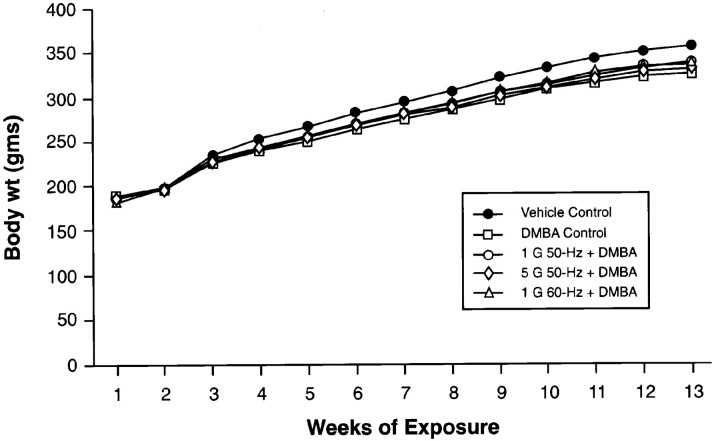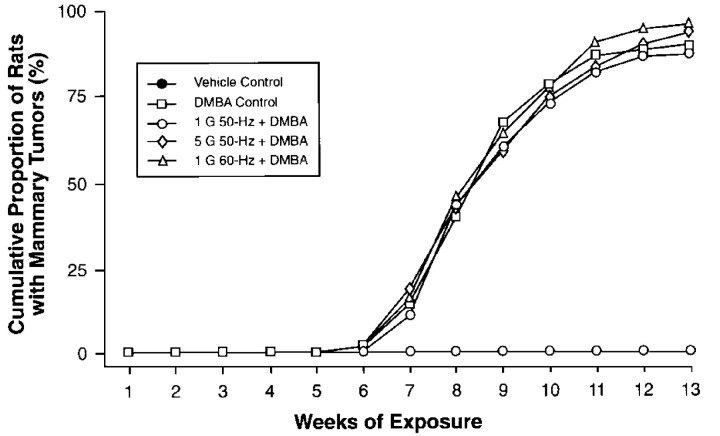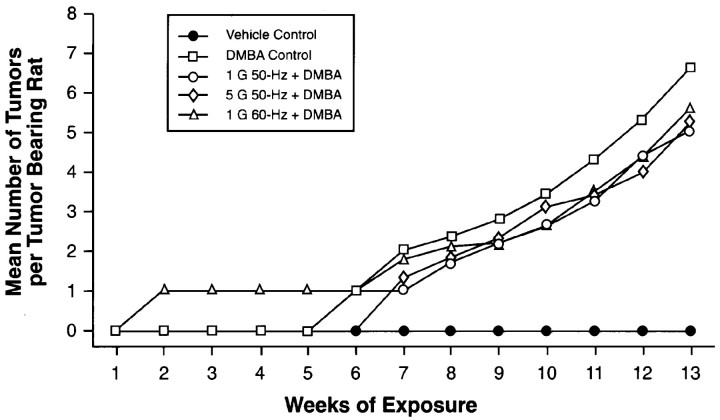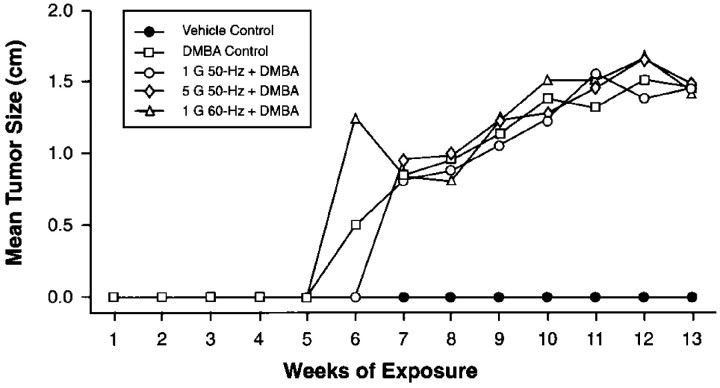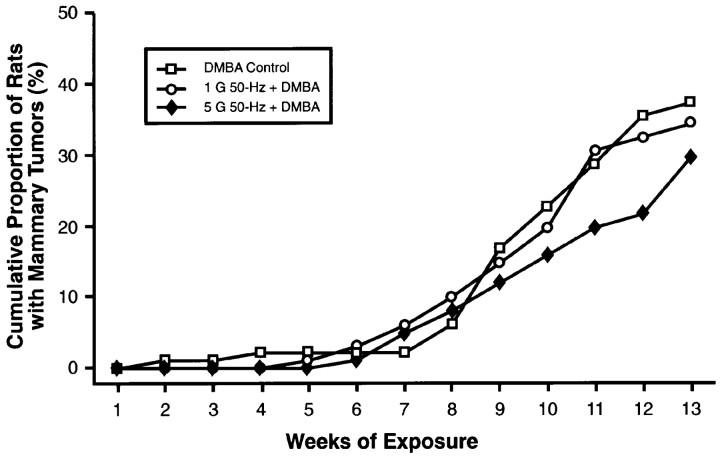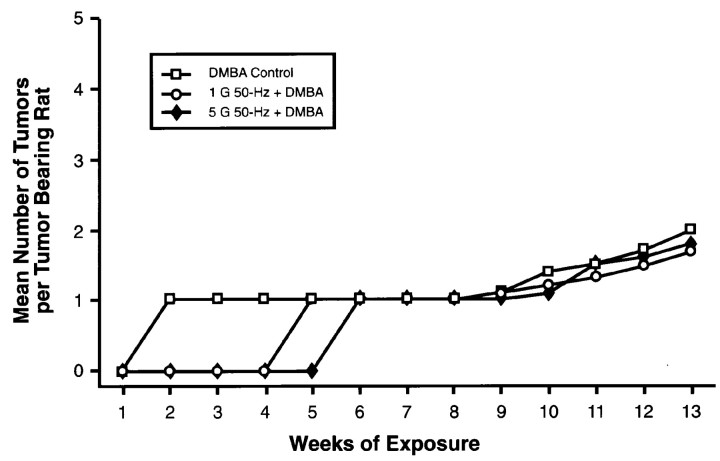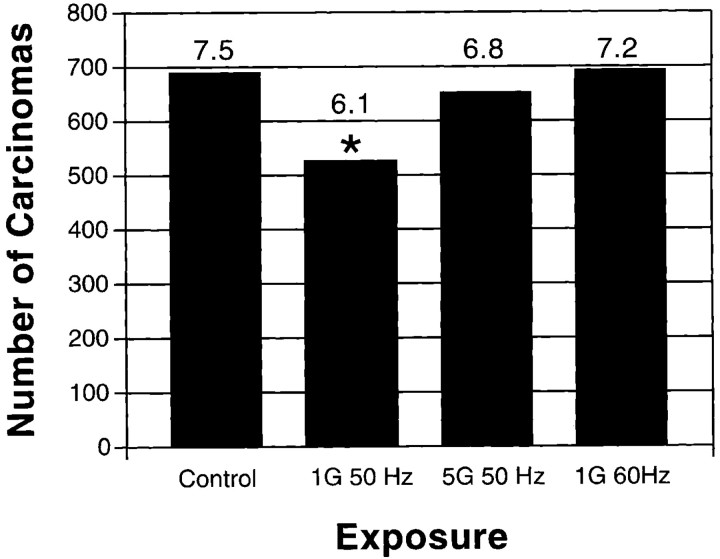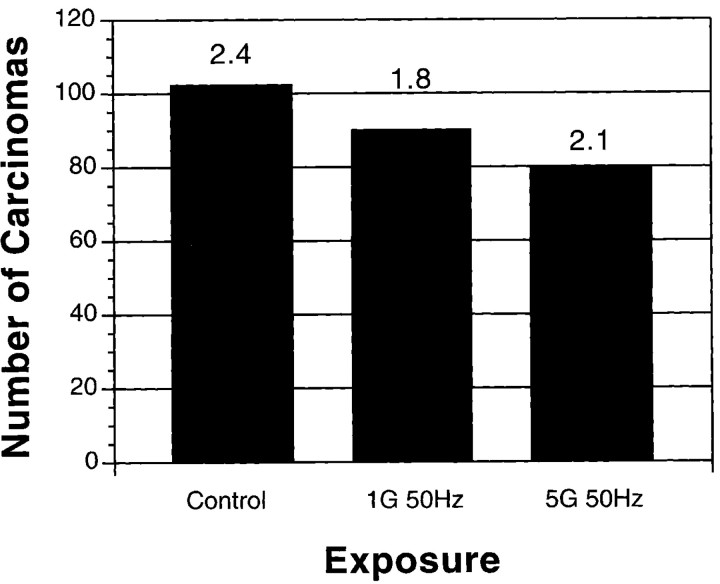Abstract
Several studies suggest that exposure to 50 Hz magnetic fields may promote chemically induced breast cancer in rats. Groups of 100 female Sprague–Dawley rats were initiated with four weekly 5 mg gavage doses of 7,12-dimethylbenz[a]anthracene (DMBA) starting at 50 days of age. After the first weekly DMBA administration, exposure to ambient fields (sham exposed), 50 Hz magnetic fields at either 1 or 5 G field intensity or 60 Hz fields at 1 G for 18.5 h/day, 7 days/week was initiated. Exposure continued for 13 weeks. A vehicle control group without DMBA was included. In a second study, using lower doses of DMBA, groups of 100 female Sprague–Dawley rats were initiated with four weekly doses of 2 mg of DMBA starting at 50 days of age followed, after the first weekly DMBA administration, by exposure to ambient fields (sham exposed) or 50 Hz magnetic fields at either 1 or 5 G field intensity for 18.5 h/day, 7 days/week for 13 weeks. Rats were weighed and palpated weekly for the presence of tumors. There was no effect of magnetic field exposure on body weight gains or on the time of appearance of mammary tumors in either study. At the end of 13 weeks, the animals were killed and the mammary tumors counted and measured. Mammary gland masses found grossly were examined histologically. In the first 13 week study, the mammary gland carcinoma incidences were 92, 86, 96 and 96% for the DMBA controls, 1 G, 50 Hz, 5 G, 50 Hz and 1 G, 60 Hz groups, respectively. The total numbers of carcinomas were 691, 528 (P < 0.05, decrease), 561 and 692 for the DMBA controls, 1 G, 50 Hz, 5 G, 50 Hz and 1 G, 60 Hz groups, respectively. In study 2, the mammary gland carcinoma incidences were 43, 48 and 38% for the DMBA controls, 1 G, 50 Hz and 5 G, 50 Hz groups, respectively. The total numbers of carcinomas were 102, 90 and 79 for the DMBA controls, 1 G, 50 Hz and 5 G, 50 Hz groups, respectively. There was no effect of magnetic field exposure on tumor size either by in-life palpation or by measurement at necropsy in either study. There was no evidence that 50 or 60 Hz magnetic fields promoted breast cancer in these studies in female rats. These studies do not support the hypothesis that magnetic field exposure promotes breast cancer in this DMBA rat model.
Keywords: DMBA, 7,12-dimethylbenz[a]anthracene; G, Gauss; T, Tesla
Introduction
Electric and magnetic fields associated with the production, transmission and use of electricity are ubiquitous in industrialized societies. These fields are predominantly of low frequency (60 Hz in the USA, 50 Hz in Europe and Japan) and generally of low intensity. Electric fields exist when there is electric potential in a line, while magnetic fields exist only when there is current flow (1). Since both electric and magnetic fields often occur together and are interactive, these fields have often been referred to as electric and magnetic fields, or EMFs. Trees, walls and other objects shield electric fields while magnetic fields usually penetrate non-ferrous material. Thus, most residential exposure is to magnetic fields. Recent research has focused on potential adverse health effects of exposure to magnetic fields. Most homes have magnetic field intensities of <2 mG or 0.2 μT, although some areas in homes may exceed this. In some industries, mean workplace magnetic field exposure may exceed 10 mG (2).
The report of two cases of breast cancer in male electricians raised concern that magnetic fields may alter the rates of breast cancer in humans, especially since breast cancer in men is a rare disease (3,4). Further concern was raised by a report of a modest increase in breast cancer in women with magnetic field exposure (5). Even a small effect of EMF on the incidence of breast cancer in women has potential major health implications. The suggestion that magnetic field exposure may depress nocturnal melatonin levels (6) provided a plausible mechanism for magnetic fields to increase breast cancer rates.
Several studies have failed to find an effect of long-term magnetic field exposure on mammary gland tumor rates in rodents (7–9). Other reports from a laboratory in Hannover, Germany suggested that 50 Hz magnetic fields may promote 7,12-dimethylbenz[a]anthracene (DMBA)-induced mammary gland cancer in female rats (10–16). In an attempt to confirm whether magnetic fields could promote breast cancer in rats, we used a DMBA initiation/promotion model in Sprague–Dawley rats with magnetic field exposure similar to conditions used in studies from the Hannover laboratory. We used repeated administration of the initiating chemical with four weekly doses of 5 mg DMBA (total 20 mg DMBA/rat) followed by 13 weeks of magnetic field promotion to test potential promoting effects of these fields on breast cancer. When this regimen caused >90% tumors in the exposure and control groups, a second study using a lower dose of DMBA (8 mg total) following the same repeated administration of the initiating chemical was conducted. We also added the American power line frequency (60 Hz) in addition to 50 Hz for the magnetic field exposures.
The results of both 13 week studies are reported here. Many studies evaluating promoting effects in carcinogenesis give a single administration of an initiator followed by a promoter; we also conducted a magnetic field study using this format. The results of single administrations of DMBA followed by 26 weeks magnetic field exposure have been reported separately (17). In that report, there was no evidence that magnetic field exposure promoted breast cancer in the DMBA rat model (17).
Materials and methods
Animals
Female Sprague–Dawley rats were obtained from Charles River Laboratory (Raleigh, NC). On receipt the animals were 37 days old. The animals were quarantined for 13 days and were 50 days of age on the first day of the study. Before initiation of the study, 10 rats were randomly selected for parasite evaluation and gross observation for evidence of disease. The study animals were randomized by weight into treatment groups using a computer-generated randomization scheme. At the end of the study, serological analyses were performed on five rats from each of the two exposure rooms. Serological evaluation for Sendai virus, pneumonia virus of mice, rat coronavirus/sialodacroadenitis virus and Kilham rat virus/H-1 virus failed to reveal any abnormalities either prior to study start or at the end of the study.
Animal room conditions
The animal room conditions have been described previously (17). Briefly, rats were housed four (first 13 week study) or five (second 13 week study) per polycarbonate cage on hardwood bedding (cages were changed twice weekly) and water and NIH-07 open formula pelleted diet were available ad libitum. The animal rooms were monitored for temperature, humidity and light status every 6 min. Cages were rotated on each rack once per week. The lights were on a 12:12 light/dark cycle with 47 lux at the bottom cages and 85 lux at the top cages. A system of dim red lighting (Phillips 15 W lamps) provided night-time lighting of <0.1 lux in the animal rooms. Temperature was maintained between 66 and 77°F and relative humidity between 35 and 65%. The exposure room had a sound level of ~59 dB, with ~53 dB in the control room. The heating of the field generating coils at 5 G was <1°C and there was no measurable change in temperature at the cage level. The Earth's static magnetic fields were measured in the animal rooms and varied between 0.48 and 0.54 G.
Chemicals
DMBA was purchased by the Analytical Chemistry Laboratory, Midwest Research Institute (Kansas City, MO) from TCI America (Portland, OR). The purity determined by HPLC was 99%, which was consistent with the manufacturer's indicated purity of 98.6%. Sesame oil was obtained from Welch, Holme and Clark Co. (Newark, NJ). The Midwest Research Institute determined sesame oil identity by infrared spectrometry; the peroxide content was determined to be 0.87 ± 0.10 meq peroxide/kg in study 1 and 6.9 meq in study 2. DMBA was mixed with sesame oil to give the desired concentrations. Five replicate gavage samples of the 5 and 2 mg doses dispensed into test tubes were received by the Midwest Research Institute and analyzed for accuracy of dosing. Three of the five samples were selected at random and analyzed in duplicate. All analyses were within 2% of the target concentration.
Magnetic field exposure generation
The exposure system has been previously described (17). Briefly, the magnetic field exposure system consisted of three identical field generating coil sets in a single room, each associated with an individual animal exposure rack. Each coil set consisted of four pairs of vertically oriented coils connected in series that were spaced on each system. Pairs of coils were stacked one above the other; the bottom coils produced horizontal magnetic fields in one direction while the top coils produced magnetic fields opposite to that of the lower coils. This arrangement helped minimize stray fields. The wires in the coils were embedded in plastic to minimize coil vibration and hum and the plastic cases of the coils could be cleaned without danger of harming the electrical hardware.
Exposure monitoring and control
The exposure monitoring and control system has been described (17). Field levels in the exposure rooms were checked every 6 min during the 13 week study and an alarm was triggered when fields were 10% out of the target field intensity. The 60 Hz stray fields did not exceed 3 mG in the 1 and 5 G, 50 Hz animal exposure areas in study 1. The stray 50 Hz fields in the 1 G, 60 Hz exposure areas varied from 5 to 30 mG (mean ± SD 11.4 ± 6.4). In study 2, there was no 60 Hz exposure group. The mean stray fields for the control animals were <1 mG in both studies. In the animal exposure areas, the target field intensity was within 10% of the measured field intensity. The long-term data storage system kept summaries of the exposure at 1 h intervals for each day. The exposure system fields were independently measured by Dr Martin Misakian of the National Institute of Standards and Technology.
Experiment protocol
The experimental design is shown in Table I. On day 1 of the study, four groups of 100 female Sprague–Dawley rats were administered 5 mg DMBA dissolved in 1 ml of sesame oil by gavage. Three additional weekly doses of 5 mg DMBA were administered by gavage. Of the four groups administered DMBA, one group received no magnetic field exposure and served as a DMBA control group. Three groups of rats administered DMBA were exposed to magnetic fields at intensities/frequencies of 1 G, 50 Hz, 5 G, 50 Hz or 1 G, 60 Hz for 18.5 h/day, 7 days/week for 13 weeks. An additional 100 female rats were administered 1 ml of sesame oil on day 1 of the study and three additional doses in succeeding weeks. These rats received no magnetic field exposure and served as a vehicle control group. In a second 13 week study, three groups of 100 female Sprague–Dawley rats were administered 2 mg DMBA dissolved in 1 ml of sesame oil by gavage. Three additional weekly doses of 2 mg DMBA were administered by gavage in corn oil. Of the three groups administered DMBA, one group received no magnetic field exposure, one group 1 G, 50 Hz and one group 5 G, 50 Hz magnetic field exposures. Rats were weighed prior to study start, weekly thereafter and again at necropsy. The rats were palpated weekly; masses were located by specific mammary gland (L1–L6 and R1–R6). Two individuals each palpated half of the rats, alternating groups of rats each week. Size was determined by comparing the palpated masses with wooden spheres of defined diameters. When there was a discrepancy between the previous week in number or size of the masses, then both individuals palpated the animal and resolved the discrepancy. At the time of necropsy, the clinical observations were available to the pathologist; additional masses were found at necropsy. The skin and mammary glands were removed and placed on a light box to visualize the tumors. Masses were measured in two directions and collected in formalin. The mammary glands, lung, liver, kidney and all masses were fixed in formalin, stained with hematoxylin and eosin and examined histologically in study 1. In study 2, the mammary glands and all masses were examined histologically. Each gross lesion was uniquely identified and followed through processing; histological diagnoses were correlated with each gross lesion identified in the mammary gland. The measurements at necropsy were used to calculate the area of the mammary gland carcinomas for each group.
Table I.
Experimental design
| Group | n | Initiation | Promotion |
|---|---|---|---|
| aVehicle controls received 1 ml of sesame oil. | |||
| bRats not exposed to magnetic fields have ambient field intensities of <1 mG. | |||
| cFive milligrams DMBA given four times at weekly intervals. | |||
| dTwo milligrams DMBA given four times at weekly intervals. | |||
| First 13 week study | |||
| Vehiclea | 100 | None | Noneb |
| DMBA | 100 | 20 mgc DMBA | None |
| 1 G, 50 Hz | 100 | 20 mgc DMBA | 1 G, 50 Hz |
| 5 G, 50 Hz | 100 | 20 mgc DMBA | 5 G, 50 Hz |
| 1 G, 60 Hz | 100 | 20 mgc DMBA | 1 G, 60 Hz |
| Second 13 week study | |||
| DMBA | 100 | 8 mgd DMBA | None |
| 1 G, 50 Hz | 100 | 8 mgd DMBA | 1 G, 50 Hz |
| 5 G, 50 Hz | 100 | 8 mgd DMBA | 5 G, 50 Hz |
Statistical methods
Comparisons of tumor incidence were made by the Poly-3 test (18–20). Comparison of tumor size and multiplicity were made by Dunnett's test (21).
Results
Environmental conditions and field measurements
In study 1, room temperature for the exposure rooms was 72.1 ± 0.6°F, whereas the room temperature for the controls was 71.6 ± 1.0°F. In study 2, room temperature for the exposure rooms was 72.5 ± 0.6°F, whereas the room temperature for the controls was 72.7 ± 0.5°F. In both studies all room temperatures were within the specified range >99% of the time. In study 1, mean humidity of the control and exposure rooms was 52%, whereas in study 2, the mean humidity was 45–46%, and all rooms for both studies were within the specified humidity range >90% of the time. The fields in the exposure rooms are shown in Table II. The independent field measurements by the National Institute of Standards and Technology found values within 2% of the target values. The fields were relatively pure sine waves with a total harmonic distortion of 0.2%.
Table II.
Summary of exposure field measurements
| Condition | Start of study | End of study | ||
|---|---|---|---|---|
| Mean ± SDa | Range | Mean ± SD | Range | |
| aField intensity in Gauss. There were two measurements in the control room but neither value exceeded 1 mG; control values are shown for the East monitor. | ||||
| Study 1 | ||||
| 5 G, 50 Hz | 5.0 ± 0.2 | 4.6 –5.4 | 5.1 ± 0.2 | 4.6 –5.4 |
| 1 G, 50 Hz | 1.0 ± 0.1 | 0.9 –1.1 | 1.0 ± 0.1 | 0.9 –1.1 |
| 1 G, 60 Hz | 1.0 ± 0.0 | 0.9 –1.1 | 1.0 ± 0.0 | 0.9 –1.1 |
| DMBA control | 0.0005 ± 0.0001 | 0.0003–0.0006 | 0.0002 ± 0.0001 | 0.0001–0.0003 |
| Study 2 | ||||
| 5 G, 50 Hz | 5.0 ± 0.2 | 4.6 –5.4 | 5.0 ± 0.2 | 4.6 –5.3 |
| 1 G, 50 Hz | 1.0 ± 0.1 | 0.9 –1.1 | 1.0 ± 0.1 | 0.9 –1.1 |
| DMBA control | 0.0002 ± 0.0001 | 0.0001–0.0003 | 0.0002 ± 0.0001 | 0.0001–0.0003 |
Body weights and mortality
In study 1, rats not receiving DMBA (vehicle controls) were 6–9% heavier than rats receiving DMBA (Figure 1). DMBA controls were 1–4% lighter than rats receiving DMBA plus magnetic field exposure, but this difference was not statistically significant. In study 2, the magnetic field exposure group body weights were within 1% of the body weight of the DMBA controls (data not shown). In study 1, 35 rats (7%) were removed from the study and necropsied prior to final killing. Removal was usually because of humane considerations. All but nine rats had mammary gland masses at gross necropsy. These early death animals were included in the study evaluation. The early deaths were similar among exposure groups, varying from six rats in the DMBA control to 13 in the 5 G, 50 Hz group, with five and eight early deaths in the other exposure groups. In study 2, with the lower doses of DMBA only one animal (5 G, 50 Hz) was removed prior to terminal killing.
wFig. 1.
Growth curves for female rats receiving either vehicle control or DMBA followed by sham or magnetic field exposure
Mammary tumor palpations
The first tumors were found at ~6 weeks in study 1 and there was an increase in the proportion of tumor-bearing rats throughout the study. There was no difference between exposure groups and DMBA controls in the time of appearance of palpable tumors or in the proportion of tumor-bearing rats (Figure 2). By 13 weeks, >90% of the rats had palpable tumors. No palpable masses were found in vehicle control rats. The mean number of tumors/tumor-bearing rat at 13 weeks based on palpation ranged from 5.0 to 5.6 in the exposed groups, with 6.6 tumors/tumor-bearing rat in DMBA controls (Figure 3). The numbers of tumors/tumor-bearing rat in the 1 G, 50 Hz and 5 G, 50 Hz groups were significantly reduced (P < 0.05) relative to controls (Table III). Mammary tumor size by palpation was similar between the exposure and DMBA control groups (Figure 4). In study 2, the first tumors were found at 5–6 weeks (with the exception of one, perhaps spontaneous, tumor at week 2; DMBA control) with an increase in the proportion of tumor-bearing rats throughout the study. There was no difference between exposure groups and DMBA controls in the time of appearance of palpable tumors or in the proportion of tumor-bearing rats (Figure 5). By 13 weeks, 30–38% of the rats had palpable tumors. The mean numbers of tumors/tumor-bearing rat at 13 weeks based on palpation were 2.0, 1.7 and 1.8 in the control, 1 G, 50 Hz and 5 G, 50 Hz groups, respectively (Figure 6 and Table III).
Fig. 2.
Cumulative proportion of female rats with palpable mammary gland tumors during the first 13 week DMBA initiation/magnetic field promotion study.
Fig. 3.
Mean number of mammary gland tumors per tumor-bearing rat during the first 13 week DMBA initiation/magnetic field promotion study.
Table III.
Evaluation of tumor size and multiplicity (mean ± SD)
| Diagnosis | DMBA plus magnetic field exposure group | |||
|---|---|---|---|---|
| Control | 1 G, 50 Hz | 5 G, 50 Hz | 1 G, 60 Hz | |
| a P < 0.05 compared with controls (Dunnett's test). | ||||
| bND, not done. | ||||
| Palpation data | ||||
| Study 1 | ||||
| Tumors/tumor-bearing rat | 6.6 ± 3.7 | 5.0a ± 3.3 | 5.2a ± 3.6 | 5.6 ± 3.3 |
| Mean tumor size (cm2) | 1.5 ± 0.8 | 1.5 ± 1.0 | 1.4 ± 0.9 | 1.5 ± 0.9 |
| Study 2 | ||||
| Tumors/tumor-bearing rat | 2.0 ± 1.4 | 1.7 ± 1.0 | 1.8 ± 1.0 | NDb |
| Mean tumor size (cm2) | 1.2 ± 0.9 | 1.4 ± 0.8 | 1.4 ± 1.1 | ND |
| Histology data | ||||
| Study 1 | ||||
| Carcinoma/rat | 6.9 ± 4.8 | 5.3a ± 4.4 | 6.5 ± 4.9 | 6.9 ± 4.8 |
| Carcinoma area/rat (cm2) | 15.0 ± 13.9 | 12.9 ± 12.5 | 12.9 ± 12.5 | 14.4 ± 10.7 |
| Ratio of area per carcinoma (cm2) | 2.2 | 2.4 | 2.0 | 2.1 |
| Study 2 | ||||
| Carcinoma/rat | 1.0 ± 1.9 | 0.9 ± 1.3 | 0.8 ± 1.3 | ND |
| Carcinoma area/rat (cm2) | 1.9 ± 4.7 | 1.8 ± 4.6 | 1.7 ± 4.8 | ND |
| Ratio of area per carcinoma (cm2) | 1.9 | 2.0 | 2.2 | ND |
Fig. 4.
Mean mammary tumor size estimated by palpation during the first 13 week DMBA initiation/magnetic field promotion study.
Fig. 5.
Cumulative proportion of female rats with palpable mammary gland tumors during the second 13 week DMBA initiation/magnetic field promotion study.
Fig. 6.
Mean number of mammary gland tumors per tumor-bearing rat during the second 13 week DMBA initiation/magnetic field promotion study.
Histological evaluation of mammary tumors
Necropsy and histological examination confirmed that nearly all of the masses palpated during the in-life phase of the study were adenocarcinomas histologically similar to adenocarcinomas found in the 26 week study (17). A few mammary gland adenomas (two in controls and one in the 1 G, 50 Hz and 1 G, 60 Hz groups) were found in study 1, whereas only one adenoma was found in study 2 using a lower dose of DMBA (Table IV). In contrast to the 26 week study, where mammary gland fibroadenomas were quite common (17), only seven fibroadenomas were found in study 1, with three of the seven tumors occurring in the control group. Fibroadenomas were not diagnosed in study 2. Lung, liver and kidney were examined for the presence of neoplastic disease, especially for the presence of metastatic mammary gland carcinomas in study 1. One DMBA control rat and one DMBA/1 G, 60 Hz rat, had liver metastases. Three rats had pulmonary metastases, (one DMBA control, one DMBA/1 G, 50 and one DMBA/5 G, 50 Hz). In study 2, distant metastases were not found in any exposure or control group, as evidenced by the presence of masses found grossly at necropsy.
Table IV.
Evaluation of tumor incidence
| Diagnosis | DMBA plus magnetic field exposure group | |||
|---|---|---|---|---|
| Control | 1 G, 50 Hz | 5 G, 50 Hz | 1 G, 60 Hz | |
| aNumber of rats with diagnosis (100 animals/group examined). | ||||
| bND, not done. | ||||
| Study 1 | ||||
| Adenoma | 2a | 1 | 0 | 1 |
| Carcinoma | 92 | 86 | 96 | 96 |
| Fibroadenoma | 3 | 2 | 1 | 1 |
| Study 2 | ||||
| Adenoma | 0 | 0 | 1 | NDb |
| Carcinoma | 43 | 48 | 38 | ND |
Using the trace gross lesions identifiers, histological diagnoses were correlated with each gross lesion identified in the mammary gland. There were significantly fewer total carcinomas in the 1 G, 50 Hz group as compared with the DMBA controls (Figure 7 and Table III). In study 2, there are also fewer carcinomas in the exposure groups (Figure 8 and Table III). Based on both in-life palpations and histological examination, there were no differences in time of tumor appearance, tumor incidence or histological tumor type between DMBA controls and the various exposure groups in either study. There was limited evidence for fewer tumors/tumor-bearing rat and fewer total carcinomas in some exposure groups compared with controls.
Fig. 7.
Total number of carcinomas found on histological examination in female rats receiving DMBA followed by sham or magnetic field exposure during the first 13 week study. The number of tumors per tumor-bearing rat is given above each bar. Three DMBA control rats had fibroadenomas and two had adenomas, whereas the exposure groups had 0–2 fibroadenomas and or adenomas per group. These data are not included in the figure.
Fig. 8.
Total number of carcinomas found on histological examination in female rats receiving DMBA followed by sham or magnetic field exposure during the second 13 week study. The number of tumors per tumor-bearing rat is given above each bar. One rat in the 5 G, 50 Hz exposure group had an adenoma. This data is not included in the figure.
Evaluation of carcinoma size
The masses were also measured at necropsy and comparison with histological diagnosis allowed for calculation of the mean carcinoma area per tumor and per rat for the DMBA control and exposure groups. The carcinoma area per carcinoma was slightly increased (not significant) in some exposure groups (Table III). This may have been due to the fewer number of tumors in the exposed animals; the carcinoma area/animal was decreased (not significant) in all exposed groups compared with the control animals. Based on both in-life palpations and measurements at necropsy, there were no significant differences in size of tumor between DMBA controls and the various exposure groups in either study.
Discussion
These two studies do not support the hypothesis that magnetic field exposure enhances breast cancer growth in the DMBA rat breast cancer model. In fact, there were significantly fewer total numbers of carcinomas in the 1 G, 50 Hz exposure group in study 1 and a tendency for fewer tumors in the exposure groups in study 2. There was also a tendency for fewer tumors/rat in the exposed groups. Our data are consistent with the findings of Ekstrom (22), who also observed fewer tumors in the magnetic field-exposed animals compared with the DMBA controls. This is also similar to a 26 week study that we reported previously (17).
The data from the two 13 week studies reported here are not consistent with studies from one laboratory suggesting that magnetic field exposure may promote chemically induced breast cancer in rats (10–15). In some studies reporting effects of magnetic field exposure, there was no difference in the number of mammary tumors/tumor-bearing rat (11,13,16,23). Some studies also reported no difference in the incidence of tumors with magnetic field exposure (10), but one of the studies involved small numbers of animals at low field intensities (13). The positive effects reported were often an earlier onset of tumors (11,16,23) or an increase in tumor size (10,11,14). However, in some studies there was no increase in tumor size (16,23). We found no indication for earlier onset of tumors, but in the second 13 week study there was a small but insignificant increase in tumor size (controls, 1.9 cm2; 1 G, 50 Hz, 2.0 cm2; 5 G, 50 Hz, 2.2 cm2). However, when the data are expressed as carcinoma area/animal there is a small decrease (controls, 1.9 cm2; 1 G, 50 Hz, 1.8 cm2; 5 G, 50 Hz, 1.7 cm2). Further, there was no tendency for an increase in tumor size in the first 13 week study (2.2, 2.4, 2.0 and 2.1 cm2 for the control, 5 G, 50 Hz, 5 G, 50 Hz and 1 G, 60 Hz groups, respectively). Thus, our interpretation is that these studies do not provide evidence that magnetic field exposure increases tumor size. Finally, the palpation data do not suggest that there is an earlier onset of tumors.
While having similar protocols to previously reported studies (10–15), there are also several important differences. We and previous studies used Sprague–Dawley rats, but the sources of the strain of rats were quite different (Exertal, Germany and Raleigh, NC), rodent feed varied and our study also had a shorter daily exposure duration (18.5 h/day, 7 days/week), whereas exposures in the Hannover studies were for 24 h/day. The reported promotional effects of magnetic fields on breast cancer in the rat are subtle and not always consistent (10–15). Further, a seasonal influence on DMBA-induced breast cancer in their model (24) has been reported. Thus, it may not be easy to replicate subtle changes that have some seasonal variation.
Several recent epidemiological studies provide less evidence for an effect of magnetic fields on breast cancer (25–28). Several long-term studies have also failed to find an increase in mammary gland cancer in rats or mice with magnetic field exposure (7–9).
In summary, the DMBA initiation/promotion studies reported here and other long-term carcinogenicity studies provide little or no support that magnetic fields at 50 and 60 Hz frequency at field intensities of 1–5 G promote the onset, size, number or incidence of chemically induced mammary gland tumors in the rat.
Acknowledgments
We thank Drs Barbara Davis and Joel Mahler for a careful review of the manuscript. We also thank the technical staff at Battelle Pacific Northwest Laboratories who conducted the studies.
Footnotes
To whom correspondence should be addressed Email: boorman@niehs.nih.gov
References
- 1.Miller,F.J. and Schroeer,D. (1987) College Physics, 6th Edn. Harcourt Brace Jananovich, San Diego, CA.
- 2.Theriault,G., Goldberg,M., Miller,A.B. et al (1994) Cancer risks associated with occupational exposure to magnetic fields among electric utility workers in Ontario and Quebec, Canada and France: 1970–1989. Am. J. Epidemiol., 139, 550–572. [DOI] [PubMed] [Google Scholar]
- 3.Matanoski,G.M., Breyese,P.N. and Elliot,E.A. (1991) Electromagnetic field exposure and male breast cancer. Lancet, 33, 737. [DOI] [PubMed] [Google Scholar]
- 4.Tynes,T. (1993) Electromagnetic fields and male breast cancer [editorial]. Biomed Pharmacother., 47, 425–427. [DOI] [PubMed] [Google Scholar]
- 5.Loomis,D.P., Savitz,D.A. and Ananth,C.V. (1994) Breast cancer mortality among female electrical workers in the United States [see comments]. J. Natl Cancer Inst., 86, 921–925. [DOI] [PubMed] [Google Scholar]
- 6.Stevens,R.G. (1987) Electric power use and breast cancer: a hypothesis. Am. J. Epidemiol., 125, 556–561. [DOI] [PubMed] [Google Scholar]
- 7.Mandeville,R., Franco,E., Sidrac-Ghali,S., Paris-Nadon,L., Rocheleau,N., Mercier,G., Desy,M. and Gaboury,L. (1997) Evaluation of the potential carcinogenicity of 60 Hz linear sinusoidal continuous-wave magnetic fields in Fischer F344 rats. FASEB J., 11, 1127–1136. [DOI] [PubMed] [Google Scholar]
- 8.Yasui,M., Kikuchi,T., Ogawa,M., Otaka,Y., Tsuchitani,M. and Iwata,H. (1997) Carcinogenicity test of 50 Hz sinusoidal magnetic fields in rats. Bioelectromagnetics, 18, 531–540. [DOI] [PubMed] [Google Scholar]
- 9.National Toxicology Program (1997) Toxicology and Carcinogenesis Studies of 60-Hz Magnetic Fields Administered by Whole Body Exposure to F344/N Rats and B6C3F1 Mice (Whole Body Exposure Studies). NIEHS, Research Triangle Park, NC.
- 10.Baum,A., Mevissen,M., Kamino,K., Mohr,U. and Loscher,W. (1995) A histopathological study on alterations in DMBA-induced mammary carcinogenesis in rats with 50 Hz, 100 μT magnetic field exposure. Carcinogenesis, 16, 119–125. [DOI] [PubMed] [Google Scholar]
- 11.Loscher,W., Mevissen,M., Lehmacher,W. and Stamm,A. (1993) Tumor promotion in a breast cancer model by exposure to a weak alternating magnetic field. Cancer Lett., 71, 75–81. [DOI] [PubMed] [Google Scholar]
- 12.Loscher,W. and Mevissen,M. (1994) Animal studies on the role of 50/60-Hertz magnetic fields in carcinogenesis. Life Sci., 54, 1531–1543. [DOI] [PubMed] [Google Scholar]
- 13.Loscher,W., Wahnschaffe,U., Mevissen,M., Lerchl,A. and Stamm,A. (1994) Effects of weak alternating magnetic fields on nocturnal melatonin production and mammary carcinogenesis in rats. Oncology, 51, 288–295. [DOI] [PubMed] [Google Scholar]
- 14.Mevissen,M., Stamm,A., Buntenkotter,S., Zwingelberg,R., Wahnschaffe,U. and Loscher,W. (1993) Effects of magnetic fields on mammary tumor development induced by 7,12-dimethylbenz(a)anthracene in rats. Bioelectromagnetics, 14, 131–143. [DOI] [PubMed] [Google Scholar]
- 15.Mevissen,M., Kietzmann,M. and Loscher,W. (1995) In vivo exposure of rats to a weak alternating magnetic field increases ornithine decarboxylase activity in the mammary gland by a similar extent as the carcinogen DMBA. Cancer Lett., 90, 207–214. [DOI] [PubMed] [Google Scholar]
- 16.Mevissen,M., Haubler,M., Lerchl,A. and Loscher,W. (1998) Acceleration of mammary tumorigenesis by exposure to 7,12-dimethylbenz(a)anthracene-treated female rats in a 50-Hz 100-μT magnetic field: replication study. J. Toxicol. Environ. Health, 53, 401–418. [DOI] [PubMed] [Google Scholar]
- 17.Boorman,G.A., Anderson,L.E., Morris,J.E., Sasser,L.B., Mann,P.C., Grumbein,S.L., Hailey,J.R., McNally,A., Sills,R.C. and Haseman,J.K. (1999) Effect of 26 week magnetic field exposures in a DMBA initiation–promotion mammary gland model in Sprague–Dawley rats. Carcinogenesis, 20, 899–904. [DOI] [PMC free article] [PubMed] [Google Scholar]
- 18.Bailer,A.J. and Portier,C.J. (1988) Effects of treatment-induced mortality and tumor-induced mortality on tests for carcinogenicity in small samples. Biometrics, 44, 417–431. [PubMed] [Google Scholar]
- 19.Portier,C.J. and Bailer,A.J. (1989) Testing for increased carcinogenicity using a survival-adjusted quantal response test. Fundam. Appl. Toxicol., 12, 731–737. [DOI] [PubMed] [Google Scholar]
- 20.Piergorsch,W.W. and Bailer,A.J. (1997) Statistics for Environmental Biology and Toxicology. Chapman and Hall, London, UK.
- 21.Dunnett,C.W. (1955) A multiple comparison procedure for comparing several treatments with a control. J. Am. Stat. Assoc., 50, 1096–1121. [Google Scholar]
- 22.Ekstrom,T., Mild,K.H. and Holmberg,B. (1998) Mammary tumours in Sprague–Dawley rats after initiation with DMBA followed by exposure to 50 Hz electromagnetic fields in a promotional scheme. Cancer Lett., 123, 107–111. [DOI] [PubMed] [Google Scholar]
- 23.Mevissen,M., Lerchl,A., Szamel,M. and Loscher,W. (1996) Exposure of DMBA-treated female rats in a 50-Hz 50-μT magnetic field: effects on mammary tumor growth, melatonin levels and T lymphocyte activation. Carcinogenesis, 17, 903–910. [DOI] [PubMed] [Google Scholar]
- 24.Loscher,W., Mevissen,M. and Haussler,M. (1997) Seasonal influence on 7,12-dimethylbenz[a]anthracene-induced mammary carcinogenesis in Sprague–Dawley rats under controlled laboratory conditions. Pharmacol. Toxicol., 81, 265–270. [PubMed] [Google Scholar]
- 25.Cocco,P., Figgs,L., Dosemeci,M., Hayes,R., Linet,M.S. and Hsing,A.W. (1998) Case–control study of occupational exposures and male breast cancer. Occup. Environ. Med., 55, 599–604. [DOI] [PMC free article] [PubMed] [Google Scholar]
- 26.Coogan,P.F. and Aschengrau,A. (1998) Exposure to power frequency magnetic fields and risk of breast cancer in the Upper Cape Cod Cancer Incidence Study. Arch. Environ. Health, 53, 359–367. [DOI] [PubMed] [Google Scholar]
- 27.Petralia,S.A., Chow,W.H., McLaughlin,J., Jin,F., Gao,Y.T. and Dosemeci,M. (1998) Occupational risk factors for breast cancer among women in Shanghai. Am. J. Ind. Med., 34, 477–483. [DOI] [PubMed] [Google Scholar]
- 28.Gammon,M.D., Schoenberg,J.B., Britton,J.A. et al (1998) Electric blanket use and breast cancer risk among younger women. Am. J. Epidemiol., 148, 556–563. [DOI] [PubMed] [Google Scholar]



